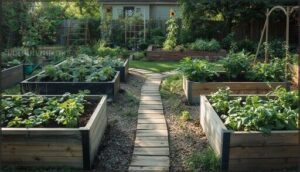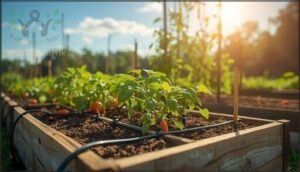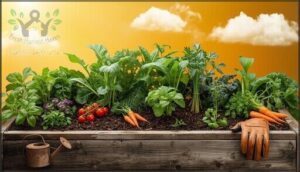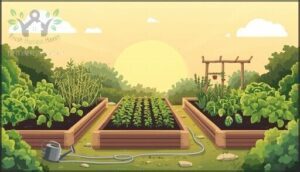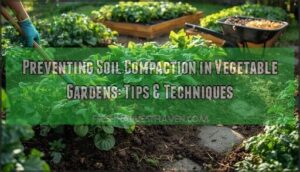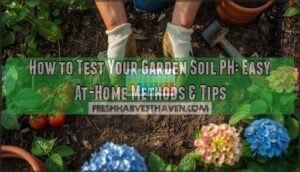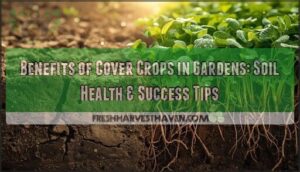This site is supported by our readers. We may earn a commission, at no cost to you, if you purchase through links.

When you build vegetable gardening in raised beds into your routine, you’ll spend less time fighting weeds and compacted clay while harvesting more tomatoes, lettuce, and peppers per square foot. The secret lies in choosing the right spot, mixing soil that drains fast yet holds moisture, and spacing plants so each one gets the sunlight and airflow it needs to thrive.
Table Of Contents
- Key Takeaways
- Planning Your Raised Bed Vegetable Garden
- Building and Setting Up Raised Beds
- Preparing Soil for Raised Beds
- Selecting and Planting Vegetables
- Maintaining and Maximizing Your Garden
- Frequently Asked Questions (FAQs)
- What vegetable grows best in a raised bed?
- How deep should my raised bed be for vegetables?
- How to arrange vegetable plants in a raised bed?
- What veggies grow best in raised beds?
- What vegetables should not be grown in a raised bed?
- How deep should a raised bed be for vegetables?
- What do you put in the bottom of a raised garden bed?
- What do you put in the bottom of a raised vegetable bed?
- What vegetables grow well in raised garden beds?
- What vegetables can you grow together in a raised bed?
- Conclusion
Key Takeaways
- Raised beds eliminate poor soil and compaction issues while delivering 20–30% higher yields than traditional gardens by providing loose, nutrient-rich growing conditions that extend your harvest season from early spring through late fall.
- Success hinges on three fundamentals: positioning beds where they’ll receive 6–8 hours of direct sunlight daily, building frames 3–4 feet wide so you never step inside to compact soil, and filling them with a 50/50 topsoil-compost mix that balances drainage with moisture retention.
- Strategic companion planting and crop rotation can boost yields up to 48% while cutting pest damage in half—pair tomatoes with basil, follow heavy feeders with nitrogen-fixing legumes, and rotate plant families through a 4-year cycle to prevent soil depletion.
- Drip irrigation paired with 2–4 inches of organic mulch slashes water consumption by 70% while automated soil sensors maintain optimal moisture levels, transforming raised bed gardening into a low-maintenance system that saves thousands of gallons annually.
Planning Your Raised Bed Vegetable Garden
A successful raised bed garden starts long before you drive your first screw or shovel your first load of soil. You’ll need to make three foundational decisions that shape everything from your daily workflow to your harvest yields.
Let’s walk through the key choices that set your garden up for long-term success.
Choosing The Best Garden Location
Location matters. Your raised bed garden needs 6–8 hours of direct sunlight daily—fruiting crops like tomatoes demand full sun, while lettuce tolerates partial shade. To increase yields, consider the importance of ideal sunlight exposure in your garden planning.
Position beds within 20 feet of a water source for easier irrigation, and shelter them from prevailing winds to reduce stem damage by 30%. Choose well-drained sites to prevent root rot and place beds near your home to boost maintenance frequency by 38%. Proper garden layout transforms accessibility into consistent yields.
Designing for Beginners and Families
Once you’ve got your site picked out, simplicity is your best friend. Keep beds 3–4 feet wide so you won’t need to step inside and compact the soil. Beginner garden plans often start with four 4×8-foot beds—enough to feed a family all season without overwhelming you.
Raised bed designs for families prioritize accessibility features: heights of 8–24 inches reduce strain, and clear 36-inch pathways accommodate wheelchairs and strollers, boosting participation by nearly 30%. Rounded corners and non-toxic materials guarantee gardening safety for kids.
These beginner tips make vegetable gardening for beginners approachable and rewarding. For improved accessibility, consider using accessible garden designs that cater to diverse needs.
Deciding Bed Size and Layout
Once you nail down accessibility, zero in on bed dimensions and soil depth. Standard 4×8-foot beds balance reach and yield, while heights between 10–18 inches support most vegetables without wasting soil.
Space beds 18–24 inches apart for pathway design that fits carts and tools. North–south layout patterns optimize sunlight, and modular configurations let you expand your raised bed vegetable garden as your skills grow—perfect for flexible garden plan evolution.
Building and Setting Up Raised Beds
Once you’ve mapped out your garden, it’s time to roll up your sleeves and build the beds themselves. The materials you choose and how you assemble them will directly affect your garden’s longevity and performance.
Let’s walk through your options, construction steps, and the finishing touches that’ll keep your plants thriving.
Selecting Materials and Raised Bed Types
Your raised bed can outlast your garden, or it can crumble before your tomatoes ripen—material comparison and bed frame options make all the difference. Cedar and cypress resist rot for 10 to 15 years, while pressure-treated lumber stretches to 20, though it may leach copper. Galvanized steel offers 25 to 30 years of garden durability, and composite boards last up to 25 years with minimal maintenance.
- Cedar: Four to five times pricier than pine but worth it for soil retention and raised bed gardening benefits
- Metal beds: Lightweight aluminum stays rust-free; galvanized steel thrives in neutral pH without zinc leaching concerns
- Composite: Hollow panels simplify modular raised bed gardening tips while resisting UV damage for decades
- Masonry: Brick or stone raised garden bed frames persist 50+ years, holding soil temperatures 2–4°C warmer
Raised bed liners protect wood from moisture and extend lifespan. Match your material to your timeline—short-term gardeners can use pine, but long-term growers benefit from investing in galvanized steel or composite for a raised bed vegetable garden that pays dividends season after season.
Step-by-Step Construction Guide
Start by excavating soil and digging six-inch trenches before adding two inches of gravel for your drainage systems and bed maintenance foundation.
Timber selection matters—cedar 2×6×8-foot boards measure 1.75 inches thick—so connect frame assembly corners with 10-inch framing angles and hex screws. Secure raised garden bed walls using ½-inch rebar driven one foot down, then line with weed barrier for raised bed gardening tips that prevent soil loss.
Fill your raised beds with layered topsoil and compost, leaving two to three inches below the rim for raised bed vegetable gardening success.
Installing Irrigation and Supports
Before you install drip irrigation in your raised beds, map out your garden design and layout to maximize water efficiency for vegetable gardening. Smart controllers with soil sensors deliver 90–95% of water directly to plant roots while cutting consumption by up to 70% compared with traditional methods. Here’s your setup plan:
- Position drip lines 30 inches apart with 0.5–1 gallon-per-hour emitters for even moisture distribution
- Install trellis systems using galvanized metal frames to reduce foliar disease by 32% through improved airflow
- Connect soil sensors to maintain 60–80% field capacity automatically, perfect for gardening for beginners
This combination transforms raised bed gardening into a low-maintenance system that saves 12,000 gallons annually while boosting yields by 18% in vertical crops.
Preparing Soil for Raised Beds
Your soil is the foundation of everything that follows—get this right, and your plants will thrive with less fuss. The mix you choose determines water retention, drainage, and how well roots can spread.
Here’s how to build soil that sets your raised beds up for success.
Creating The Ideal Soil Mix
Think of soil composition like baking—get the ratios right, and everything thrives. University research points to a 50/50 blend: equal parts topsoil and compost by volume. This mix delivers the nutrient balance and organic matter content (25–50% by volume) that vegetables crave.
For better drainage in clay-heavy soil, try a three-way split: 34% topsoil, 33% coarse sand, 33% compost. Most vegetables flourish when pH levels sit between 6.2 and 6.8—slightly acidic soil unlocks maximum nutrient uptake. Test your mix before planting; you’ll avoid guesswork and set the stage for organic gardening success in your raised bed gardening setup.
| Component | Recommended Ratio |
|---|---|
| Topsoil | 50% by volume |
| Compost | 50% by volume |
| Sand (if needed) | 33% in 3-way blend |
Adding Compost and Amendments
Layering in amendments isn’t about dumping more—it’s about feeding your soil ecosystem the right fuel. Compost types matter: mushroom compost naturally corrects acidic soil pH with gypsum, while standard compost supplies roughly equal nitrogen, phosphorus, and potassium in gentle doses.
Here’s your amendment playbook for raised bed gardening success:
- Top-dress 2–3 inches of compost twice yearly (spring and fall) to maintain organic matter and support nutrient cycling in your organic gardening methods.
- Blend in 25–30% compost when revitalizing beds, balancing fertility without overload—this ratio boosts yields up to 25% through improved soil preparation.
- Test soil pH annually, aiming for 6.0–7.0 where most vegetables and companion planting schemes thrive, adjusting with amendments as needed.
Worm castings at 5–10% volume, biochar, and cover crop residues round out a diverse amendment strategy that powers vegetable gardening from root to harvest.
Preventing Soil Compaction and Erosion
Your beds hold rich soil, but foot traffic can undo months of work—compaction crushes air pockets roots need. Keep pathways clear and beds narrow enough to reach across without stepping in, cutting compaction incidents by 85%.
Layer 2–3 inches of straw or wood chip mulch to slash erosion by 90% and lock in moisture. Cover crops like rye stabilize soil structure between seasons, reducing both erosion and compaction by over 30% while feeding your next planting cycle.
Selecting and Planting Vegetables
Your plant choices will make or break your raised bed success. The key is matching vegetables to your local growing seasons and pairing them strategically to boost growth and fend off pests.
Let’s break down the timing, partnerships, and spacing that turn a bed of soil into a productive garden.
Cool-Season Vs. Warm-Season Crops
Understanding the difference between cool-season and warm-season crops transforms your raised bed strategy. Cool-weather vegetables thrive when soil temperatures sit between 40°F and 75°F, while warm-weather crops demand at least 60°F soil and won’t tolerate frost.
- Cool-season picks (spinach, kale, carrots) can be planted 2–8 weeks before your last spring frost and again in late summer for fall harvests—doubling your yield potential.
- Warm-season stars (tomatoes, peppers, cucumbers) need planting after all frost danger passes, usually requiring 75–120 days to mature.
- Temperature Control matters: raised beds warm soil 8–12°F faster than ground plots, letting you start planting earlier in spring.
- Frost Management: cool crops survive light frost down to 28°F and actually taste sweeter after a cold snap, while warm crops suffer 60% yield loss from frost exposure.
- Seasonal Planning and crop rotation let you shift seamlessly—harvest spring greens, then drop in tomato transplants for summer bounty.
Companion Planting Strategies
Once you’ve matched your crops to their season, pairing the right plants together amplifies every benefit. Companion planting strategies boost pollinator attraction by up to 38% in diverse beds and cut pest damage nearly in half. Marigolds intercropped with tomatoes drop thrip counts by 36%, while radishes beside squash reduce bug-related losses by 27%.
Legumes like bush beans enrich soil nitrogen by 22% and slash fertilizer costs, and polyculture setups deliver 32% higher yields than solo crops.
Microclimate management—like shade-tolerant greens under tall tomatoes—retains 19% more moisture during summer heat, proving that smart partnerships transform raised bed vegetable gardening into a self-supporting system.
Proper Plant Spacing and Depth
Smart partnerships only work when you give each plant room to thrive. Proper plant spacing and depth prevent overcrowding, which cuts yield by 30% and doubles pest trouble. Six-inch beds suit lettuce and herbs, while tomatoes need 18 inches for strong root growth.
Follow these crop density rules for yield optimization:
- Bush beans: 3–4 inches apart for 4x more plants per square foot
- Carrots: 2–3 inches spacing fits 800 plants in 50 square feet
- Tomatoes: 24–36 inches between plants ensures airflow and quality fruit
- Lettuce heads: 10 inches apart; leaf types 3–6 inches
- Peppers: 14–18 inches spacing maximizes growth in raised beds
Ideal spacing boosts vegetable garden planning with 20–30% higher yields and harvests 10–15 days earlier.
Maintaining and Maximizing Your Garden
Once your beds are planted, the real work begins—keeping plants healthy, productive, and pest-free throughout the season. Smart watering, proactive pest control, and strategic crop rotation will help you squeeze every ounce of harvest from your raised beds.
Let’s cover the essential maintenance practices that separate thriving gardens from struggling ones.
Watering and Mulching Techniques
With just an inch or two weekly—roughly 62 gallons per 100 square feet—you’ll keep raised beds thriving. Drip irrigation cuts water waste by up to 75%, delivering moisture straight to roots and promoting water conservation. Pair it with irrigation scheduling to automate garden maintenance.
Layer 2–4 inches of organic mulch materials like straw or shredded leaves over moist soil to slash watering needs by 70%, regulate soil moisture, and support vigorous vegetable gardening through smart soil preparation.
Pest and Disease Management
Your soil and mulch keep moisture in check—now protect your crops from threats. Over 40% of home gardeners now rely on biological control and beneficial insects instead of synthetic chemicals for pest management.
Monitor plants weekly to catch aphids or powdery mildew early, when physical barriers like row covers can stop damage before it starts.
Pair organic pesticides with integrated management strategies, companion planting, and disease prevention techniques to keep your raised beds productive all season in successful vegetable gardening.
Seasonal Crop Rotation and Yield Tips
Rotating crops between your raised beds annually slashes pest buildup by 40–60% while boosting yields up to 48% compared to planting the same spot repeatedly. Divide vegetables by family—Solanaceae, Fabaceae, Brassicaceae—and shift them each season for soil management success.
- Plan a 4-year cycle across four beds so no family repeats in the same spot for three years
- Plant legumes (peas, beans) to add up to 200 lbs/acre of nitrogen for heavy feeders that follow
- Fill gaps with fast crops like lettuce or radishes in June and July for three harvests per bed yearly
- Log your layout each season to track rotation patterns and optimize harvest strategies in vegetable gardening
Frequently Asked Questions (FAQs)
What vegetable grows best in a raised bed?
Imagine this: you plant lettuce seeds in spring, and within weeks, you’re harvesting crisp leaves while your neighbor’s ground-level garden is still struggling with weeds.
While your neighbor battles weeds, you’re already harvesting crisp lettuce weeks ahead thanks to raised bed gardening
Lettuce, carrots, and radishes grow best in raised beds, thriving in the loose, nutrient-dense soil that prevents compaction and aids rapid root development.
How deep should my raised bed be for vegetables?
You’ll want a minimum of 12 inches for most vegetables, but deeper is better—18 to 24 inches fosters vigorous root development, improves water retention, and gives you access to more nutrients in the soil volume below.
How to arrange vegetable plants in a raised bed?
Everyone obsesses over what to plant, but few master where to put it.
Arrange vegetables by height (tall at north), growth habit (vining upward), and companionship—optimize plant density through vertical gardening and spatial planning while keeping crop rotation in mind for raised bed success.
What veggies grow best in raised beds?
Leafy greens like lettuce and spinach thrive with shallow roots.
Root vegetables such as carrots and radishes excel in loose, well-draining soil.
Herbs, tomatoes, and zucchini deliver abundant vegetable yields with proper spacing and crop rotation.
What vegetables should not be grown in a raised bed?
Imagine a tangled root system cracking through wood planks—some crops just won’t cooperate in confined spaces. Deep-rooted vegetables like parsnips, invasive plants like mint, heavy feeders such as tomatoes, and tall vegetables including corn struggle in raised beds due to space-intensive growth patterns.
How deep should a raised bed be for vegetables?
Most vegetables thrive in raised beds 8 to 12 inches deep, providing adequate soil volume for root growth and drainage.
Shallow-rooted crops like lettuce need just 6 inches, while carrots and potatoes perform best at 18 to 24 inches for maximum vegetable yield.
What do you put in the bottom of a raised garden bed?
You’re building from the ground up—literally. Start with cardboard or landscape fabric as bed liners to suppress weeds by up to 90%.
Next, add drainage materials like gravel to boost water flow by 30%, preventing root rot.
Layer organic matter such as logs or compost to cut topsoil needs by half while enriching soil amendments over time.
What do you put in the bottom of a raised vegetable bed?
Your bottom layers matter more than you think. Start with 2-4 inches of drainage materials like gravel or rocks, then add weed barriers such as hardware cloth to block pests.
Top it off with organic fillers—leaves, straw, or compost—to boost soil amendments naturally.
What vegetables grow well in raised garden beds?
Sure, you could grow anything in the ground—if you enjoy wrestling with weeds and hard-packed clay. Root crops like carrots, beets, and radishes thrive in raised beds’ loose soil. Leafy greens such as lettuce, spinach, and arugula produce abundantly.
Warm-season options including tomatoes, cucumbers, and peppers benefit from elevated soil temperature effects and better drainage.
What vegetables can you grow together in a raised bed?
Companion planting pairs complementary crops to optimize space and health. Plant tomatoes with basil, carrots with onions, or beans with corn—intercropping can boost yields up to 175% while improving soil nutrients and pest resistance naturally.
Conclusion
Next spring, when frost-free days finally arrive, you’ll stand over beds brimming with seedlings that outpace ground-level crops by weeks.
Vegetable gardening in raised beds rewards every hour you invest in soil prep, smart spacing, and steady watering with baskets of produce that taste better than anything at the grocery store.
Keep rotation schedules tight, mulch thick, and your succession plantings rolling—you’ll harvest more food from less space than you ever thought possible.
- https://gardenbetty.com/how-much-to-plant-in-a-vegetable-garden-to-feed-a-family/
- https://acsess.onlinelibrary.wiley.com/doi/full/10.2134/urbanag2018.06.0002
- https://snugnitureonline.com/blogs/raised-garden-bed-introduction/benefits-of-raised-garden-beds-2025
- https://garden.org/thread/view/187028/Maximizing-Yukon-Gold-Potato-Yield-in-4-x-8-Raised-Bed---Data-Needed/
- https://experts.illinois.edu/en/publications/raised-beds-for-vegetable-production-in-urban-agriculture

